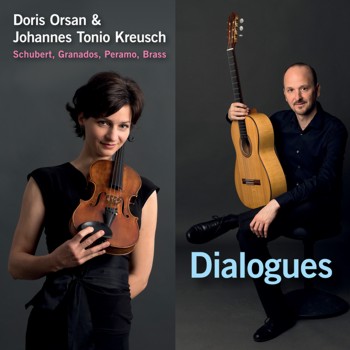CD: Dialogues
back to Classical / Jazz / World

Release date: 2015
Buy this album
Highly recommended!
Akustik-Gitarre
Feat.:
Doris Orsan: violin
Johannes Tonio Kreusch: guitar
Tracks
Franz Schubert: Sonata “Arpeggione” D.821
01: Allegro moderato
02: Adagio
03: Allegretto
Enrique Granados: 3 Danzas Espanolas
04: Andaluza
05: Oriental
06: Villanesca
Tulio Peramo Cabrera: Piezas para violin y guitarra
07: Preludio
08: Danza a tres
09: Habanereando
10: Crepuscular
11: Cancion sin palabras
12: Zapateadero
Nikolaus Brass
13: Dia loghi d’amore VII
Further audio samples can be found at: https://www.galileomusic.de/…_Dialogues
Cutups
Acoustic guitar: “Highly recommended!”
Münchner Merkur: “Doris Orsan’s violin is a prima donna, singing as expressively as the Spanish Montserrat Caballé once did.”
Süddeutsche Zeitung: “Classic innovators”
about: Dialogues
With the extraordinary combination of violin and guitar, Doris Orsan and Johannes Tonio Kreusch shed new light on famous masterpieces by Franz Schubert (Sonata “Arpeggione”) and Enrique Granados (“Danzas Espaolas”). The Cuban composer Tulio Peramo and the Munich composer Nikolaus Brass will each be presented with a world premiere of their works dedicated to the duo.
From the booklet text:
At the time of Franz Schubert (1797-1828), the guitar was a popular chamber music instrument. Schubert himself is said to have mastered the guitar playing and was weighed in with the plucked sound of the guitar, as shown by the many song arrangements with guitar accompaniment that were released in his lifetime. In 1823, the Viennese violin and guitar maker Johann Georg Stauffer developed the “Guitarre D’Amour” as a cross between guitar and Viola Da Gamba. The instrument called “Arpeggione” by Franz Schubert was a kind of guitar cello, which was painted with a bow, but was tuned like a six-string guitar and provided with cuffs. Franz Schubert got the suggestion for this guitar cello to compose by the guitar and arpeggione player Vincenz Schuster, who also wrote a textbook for the Arpeggione. It was also Schuster who premiered Schubert’s composition only one year after the invention of this instrument. The lovely sound of the Arpeggione could not prevail for long. So it was like the guitar, which was sidelined after initial popularity in the second half of the 19th century – with the difference that the guitar was able to resume its development later. When Schubert’s Arpeggione Sonata was published posthumously in 1871, the instrument hardly existed in this form. In addition to a voice for cello, the release was also supplemented with a voice for violin, which is also the basis of the recording to be heard here. With this sonata, Franz Schubert saved the arpeggione from oblivion and helped to re-engage with this instrument today.
https://www.glm.de/produkt/doris-orsan-johannes-tonio-kreusch-dialogues/